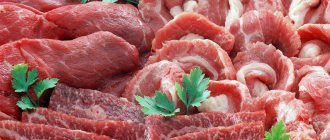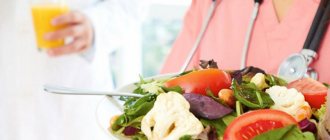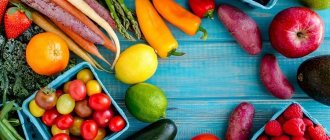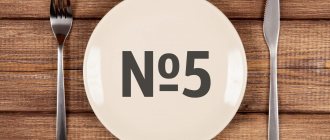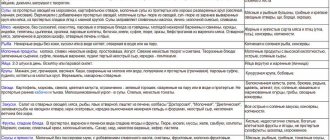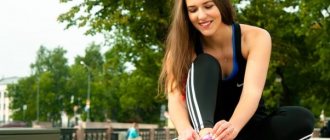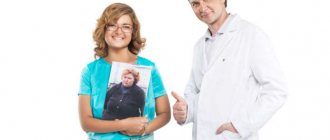11/28/2019 Article
- general characteristics
- Table "Do's and Don'ts"
- Menu for the week
The medical diet “Table 13” has proven itself as an effective remedy in the treatment of infectious diseases and is recommended by many leading specialists in the field of gastroenterology. The diet helps restore strength, helps reduce the load on the digestive system and remove accumulated toxins, and also increases the body's resistance to acute infections.
The essence of the diet
Table number 13 according to Pevzner supports the overall strength of the body, helps reduce intoxication and increases resistance to various infectious diseases.
During bed rest, the diet has a low energy value - 2000-2300 calories. In her menu, the amount of carbohydrates and fats consumed is reduced, while the amount of fortified foods is increased.
Chemical composition of the daily diet:
- Carbohydrates – 300-350 grams;
- Proteins – 70-80 grams (30-40% vegetable);
- Fats – 60-70 grams (80% animals).
The table allows adding table salt to food in the amount of 8-10 grams.
The volume of free fluid intake should be as high as possible. The patient must drink at least 2 liters of pure non-carbonated water per day, in addition to teas, juices, compotes and soups.
Description
The basic principle of nutrition in a therapeutic diet, table number 13 according to Pevzner, is a reduced energy value of the daily diet by reducing the consumption of carbohydrates, on average 2200 kcal. During treatment, the patient is given a menu for the week, which must be strictly followed.
With a therapeutic diet, table number 13 according to Pevzner, protein and vitamin products predominate in the diet. At the same time, meals are frequent, at least 5 times a day in small portions. Products should be consumed in heat-treated form in the first stages of treatment, and raw during the recovery period.
How I lost half my weight in six months
For medical reasons, it is prohibited to eat oven-baked, fried and stewed foods during a therapeutic diet, table number 13 according to Pevzner, especially for children. It is recommended to reduce salt intake to 6 grams per day, and increase the volume of liquid consumed to 2-2.5 liters per day.
What you can and cannot eat
popular:
- ✅ Strange but effective weight loss methods used by celebrities
- ✅ Effective Biocomplex formula helps get rid of food addiction
- ✅ Minus 24 kg without leaving home! A Muscovite who lost weight in quarantine “blew up” Russia with her recipe
When following a therapeutic diet, table number 13 according to Pevzner, the patient is given a balanced menu, which must be followed from one week to two. The diet is dominated by foods containing animal proteins, vegetable fats, and a small amount of carbohydrates.
For medicinal purposes, especially for acute respiratory diseases, including for children, it is recommended to exclude herbs and spices, spicy dishes and snacks from the diet, and limit the consumption of raw fruits and vegetables and dairy products.
The menu for the therapeutic diet, table number 13 according to Pevzner, is low-calorie - 2200 kcal per day, and balanced due to a variety of recipes. The products are steamed, boiled, and served as puree. The diet is dominated by the following dishes: porridge, soups, low-fat fish, poultry and meat, omelettes and soft-boiled eggs, fermented milk drinks, heat-treated vegetables.
Indications
The therapeutic diet table number 13 according to Pevzner is effective for acute infectious diseases, bronchiectasis, respiratory tract organs, bronchitis, pneumonia, with a high degree of obesity, after severe operations in both adult patients and children.
An innovative drug for losing weight by 30-40 kg! Removes even age-related fat without chemicals, liposuction, diets or exercise. Exercises
The doctor prescribes a therapeutic diet for the patient, table number 13 according to Pevzner, based on medical indications, prescribing an approximate or detailed menu for a week.
A feature of the therapeutic diet table number 13 according to Pevzner is its restorative characteristics, which allows you to quickly strengthen the body after suffering infectious diseases.
For children
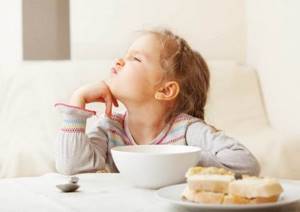
Therapeutic diet table number 13 according to Pevzner is indicated for children. With its help, toxins are removed from the body of a young patient, the immune system is activated, and the natural processes of the organs and tissues of the body are restored. It is recommended that children follow the therapeutic diet table number 13 according to Pevzner after suffering respiratory tract diseases, acute infections, and pneumonia.
It is especially important when treating children to strictly adhere to the menu prescribed by the doctor. Meals should be small portions, but frequent, at least 5-6 times a day. It is recommended to drink plenty of fluid, at least 2-2.5 liters per day. Children are served thermally processed food, mainly in the form of soups and purees. For taste, you can add honey, jam, preserves to the porridge.
How to avoid obesity and regain an erection at any age?
What is possible, what is not
For a speedy recovery, diet No. 13 obliges you to include easily digestible foods in the menu that do not contribute to flatulence and constipation. Allowed:
- Day-old wheat bread and crackers from it, biscuits;
- Slimy and ground porridges made from oatmeal, buckwheat, rice and semolina;
- Pasta as a separate side dish, as an additive to mashed potatoes or the basis of a casserole;
- Soups based on mucous and vegetable broths, light fish and meat broths;
- Low fat dairy products - kefir, yogurt, cottage cheese, unsalted cheese, sour cream. Whole milk and cream can only be used as ingredients in dishes;
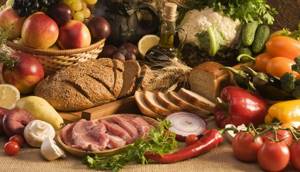
- Low-fat varieties of meat and fish, boiled and baked, various ground and mushy dishes;
- Eggs no more than 2 per day;
- Fresh and thermally processed vegetables;
- Soft, ripe and sweet fruits in the form of souffles, purees or mousses;
- Sweets in limited quantities - jam, jam, honey, pastille, meringue, marmalade;
- Butter and cold-pressed oils up to 100-150 grams per week;
- Black and green tea, chamomile and rosehip decoction, weakly concentrated juices, jelly, compotes, fruit drinks.
Diet table number 13 excludes foods that are difficult for the stomach from your diet. The following are prohibited:
- Hot baked goods;
- Barley, millet, pearl barley and corn cereals;
- Legumes - peas, lentils, chickpeas, beans;
- High-fat dairy products, gastronomic yoghurts and curds with various fillings;
- Fatty meats and rich broths made from them;
- Vegetables - cucumbers, onions, garlic, white cabbage and radishes;
- Unripe and sour berries, fruits, with a predominance of fiber;
- Marinades and pickles;
- Spicy and smoked dishes;
- Chocolate, cocoa, confectionery with cream fillings;
- Sweet carbonated drinks, alcohol.
What can you eat
The patient's condition can be improved by using the following products:
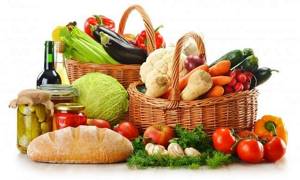
- fruits and berries (ripe and sweet);
- eggs;
- wheat bread (dried);
- meat (beef, rabbit or veal, chicken fillet, turkey);
- low-fat fish dishes;
- pasta;
- cereals (buckwheat, semolina, rice, oatmeal);
- vegetables (zucchini, pumpkin, potatoes, tomatoes, cauliflower, beets, carrots);
- low fat dairy products.
Drinks allowed include fruit drinks, jelly, herbal infusions, natural juices, and weak tea.
Menu for every day
Diet number 13 helps to protect the gastrointestinal tract. In case of severe inflammatory processes, the menu is designed in such a way as to exclude food irritants and create a favorable environment for a quick recovery.
During the period of infectious diseases, the patient’s diet should be divided and as varied as possible. During the day, you get 5-6 meals every 2-3 hours. In addition to the usual breakfast, lunch and dinner, it is necessary to arrange snacks. This way a person will not overload the stomach (portion sizes are within 300 milligrams) and at the same time will not give him the opportunity to signal a feeling of hunger.
Possible menu option for the week:
Monday
- Breakfast: semolina with cherry jelly;
- Snack: fruit puree;
- Lunch: fish noodle soup, steamed beef cutlets;
- Afternoon snack: biscuits, rosehip decoction;
- Dinner: boiled pollock fillet with vegetables.
Tuesday
- Breakfast: sweet omelet, tea with lemon;
- Snack: blueberry soufflé;
- Lunch: vegetable soup with meatballs, navy pasta;
- Afternoon snack: boiled beets with sour cream;
- Dinner: lazy cabbage rolls, a glass of kefir.

Wednesday
- Breakfast: steamed cheesecakes with sour cream, rice uzvar;
- Lunch: pear pudding;
- Lunch: beetroot, buckwheat with beef liver;
- Afternoon snack: mincemeat of soaked herring, berry compote;
- Dinner: vegetable casserole.
Thursday
- Breakfast: low-fat cottage cheese with raisins and dried apricots, tea;
- Snack: baked apple;
- Lunch: chicken soup with dumplings, potatoes with goulash;
- Afternoon snack: stewed carrots, apple and pear juice;
- Dinner: young beef soufflé.
Friday
- Breakfast: pureed rice porridge, coffee with milk;
- Snack: baked pumpkin slices with honey;
- Lunch: milk noodle soup, steamed chicken balls;
- Afternoon snack: 50-60 grams of marmalade, oat broth;
- Dinner: sea bass aspic, a glass of fermented baked milk.

Saturday
- Breakfast: oatmeal porridge with milk, strawberry compote;
- Snack: dumplings with potatoes in sour cream;
- Lunch: cream cheese soup, meatballs with fresh tomato;
- Afternoon snack: vegetable pudding, toast with a thin layer of apple jam;
- Dinner: liver cake, a glass of yogurt.
Sunday
- Breakfast: pasta with sour cream sauce or grated cheese;
- Snack: curd and raspberry dessert;
- Lunch: cauliflower soup, toasted bread with meat pate;
- Afternoon snack: stewed zucchini with minced meat;
- Dinner: hake baked with carrots in the sleeve, a glass of kefir.
Basic principles of dietary table No. 13
Table No. 13 should support the body in the fight against infection, help reduce intoxication and provide a sufficient amount of protein and vitamins for normal metabolism, while sparing the gastrointestinal tract.
The amount of fats and carbohydrates in the diet is sharply reduced; easily digestible proteins are preferable, mainly from fermented milk products and cottage cheese. All heavy, difficult-to-digest foods, legumes and other foods that promote flatulence, vegetables and fruits containing coarse fiber, fatty, salty, fried foods are excluded. Food should be at a comfortable temperature.
Dish recipes
Diet number 13, despite all its limitations, can be tasty and varied. All dishes should be boiled or steamed and served in porridge, puree, mashed or chopped form. But even taking into account the permitted heat treatment and a minimum of serving methods, you can find and come up with many interesting recipes.
Semolina
Ingredients:
- 100 grams of semolina;
- 180 grams of sugar;
- 3 tbsp. l. raisins;
- 4 eggs;
- 1 glass of milk;
- A pinch of vanillin.
Preparation:
Separate the yolks from the whites. Grind the first with sugar, beat the second until thick foam and put in the refrigerator. Boil the semolina porridge in milk and pour the yolks and sugar into it in a stream, stirring constantly. Then add raisins to the semolina mass and carefully fold in the whites. Place the finished “dough” in a greased form and place in a preheated oven for 25-30 minutes. When serving, pour jam or preserves over the semolina.
Diet table No. 13, when strictly followed, gives good results. Together with drug treatment, it can literally get a patient out of bed in just a week: remove toxic substances from the body, remove inflammatory processes in affected tissues, and improve immunity.
THESE ARTICLES WILL HELP YOU LOSE WEIGHT
Your feedback on the article:
( 768 ratings, average: 4.48 out of 5)
Recipes for Table No. 13
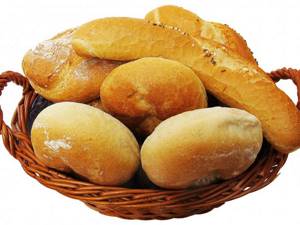
Cream soup with chicken. Cook chicken broth, remove from heat. Place a paper towel on the surface and remove it with a slotted spoon. Repeat until all the fat is removed. Take a liter of broth, the rest can be frozen for next time. Steam two chicken breast fillets and puree in a blender with a small amount of broth. Place a tablespoon of flour in a dry frying pan, fry until golden brown, stirring vigorously, pour in 1-2 cups of broth in a thin stream. Combine the rest of the broth, chicken puree, and sauce in a saucepan. Pour in a glass of 10% cream, stirring, bring to a boil, but do not boil. Add salt to taste. When serving, add white croutons to the plate.
Fish soufflé Remove bones from 400 grams of fish. Pass through a meat grinder along with 100 grams of white bread without crusts or a white savory roll. Pour in 100 ml of milk and 30 grams of melted butter, add 3 eggs, beat with a blender. Place in a greased pan and spread 1 tbsp on top. spoon of sour cream. Bake at 200 degrees for 40–45 minutes.
Broccoli puree Boil 400 grams of broccoli florets in salted water. Drain in a colander. Grind with a blender. Add ⅓ glass of milk, stirring, and cook the puree until thick. Add 20 grams of oil.
Pumpkin dessert Cut 300 grams of pumpkin into slices, sprinkle with sugar and place in the oven for 30-40 minutes. Grind with a blender. Place pumpkin and sour cream in layers in a bowl, pour honey on top to taste.
What ingredients are prohibited?
The human body, which is in the period of rehabilitation after previously suffering pathologies of an infectious nature, requires a gentle attitude, so medical experts recommend familiarizing yourself with the list of food products, the consumption of which can lead to a deterioration in the general condition, slower rehabilitation and negative reactions from the gastrointestinal tract. If you follow diet No. 13 according to Pevzner, it is recommended to completely avoid consuming the following food ingredients:
- Products containing cocoa, concentrated coffee.
- Pastry and puff pastry products, freshly baked bread.
- Dairy products with a high percentage of fat, including pure cream and milk.
- Fruit and vegetable ingredients rich in plant fiber.
- Meat and fish ingredients subjected to salting, preservation, pickling and smoking, sausages and sausages, as well as varieties of fish and meat with high fat content.
- Some types of vegetables (cucumbers, onions, radishes, radishes, garlic, white cabbage and mushrooms).
- Corn grits and pearl barley, pasta and all types of legumes.
- First courses cooked in concentrated fish or meat broth.
Indications for the use of diet No. 13 (in combination with drug treatment):
- acute tonsillitis;
- pharyngitis;
- laryngitis;
- tracheitis;
- acute bronchitis;
- pneumonia (pneumonia);
- other purulent diseases of the larynx, trachea and lungs;
- other infectious diseases in acute form, which are accompanied by weakness, headache, fever, etc.
What not to eat
It is necessary to remove the following foods from the diet of the sick person:

- broths with mushrooms or meat (too fatty);
- fruits and berries of sour varieties;
- vegetables (onions, garlic, cucumbers, radishes, white cabbage);
- legumes;
- fatty products made from milk;
- cereal grains (pearl barley, barley, corn, millet);
- pickles;
- spicy food;
- sweet buns.
During treatment, you should forget about alcohol and sour drinks.
Recipes
Here are a few recipes that we suggest preparing with this therapeutic diet.
Syrniki

- Two packs of cottage cheese
- Half a cup of flour
- Two eggs
- Sugar and salt to taste
Grind sugar with eggs and cottage cheese until smooth, add flour and knead the dough. Form cheesecakes from the dough, roll them in flour and fry over medium heat for two minutes on each side.
Baked apple with cottage cheese and honey
- 4 apples
- Half a pack of cottage cheese
- Two tablespoons of honey
Core the apples. Mix cottage cheese and honey. Place the apples on a baking sheet greased with vegetable oil and place the filling in place of the cut out core. Place in the oven for 15 minutes. Oven temperature – 180 degrees.
Chicken noodle soup
- Chicken breast
- Carrot
- bulb
- Handful of vermicelli
Remove the skin from the chicken breast and place it in a saucepan. Fill with cold water, add the peeled onion, bring to a boil and cook for an hour, skimming off the foam. Cut the carrots into cubes and add to the broth. Remove the breast, cool, chop and return to the broth. Three minutes before the end of cooking, add salt to taste, add vermicelli, stir thoroughly. Turn off the heat under the soup, close the lid and let it brew for 15 minutes.
